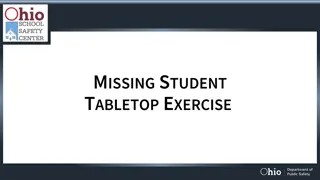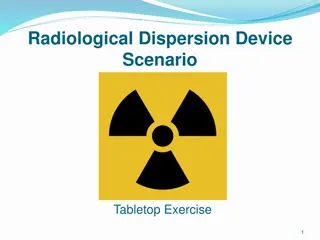Hurricane Scenario Tabletop Exercise: Enhancing Emergency Response Preparedness
Engage in a tabletop exercise focused on a hurricane scenario to enhance emergency response preparedness. The exercise includes introductions, agenda review, scenario discussions, action planning, and benefits such as improved readiness and skills practice in a safe environment. Objectives aim to refine roles, build relationships, and enhance response plans for hurricane incidents.
Download Presentation

Please find below an Image/Link to download the presentation.
The content on the website is provided AS IS for your information and personal use only. It may not be sold, licensed, or shared on other websites without obtaining consent from the author. Download presentation by click this link. If you encounter any issues during the download, it is possible that the publisher has removed the file from their server.
E N D
Presentation Transcript
Hurricane Scenario Tabletop Exercise 1
Tabletop Exercise Welcome and introductions Discuss agenda for the day Review administrative details Start the exercise 2
Welcome and Introductions Name Organization Emergency response experience 3
Agenda Review exercise materials and rules Review scenario(s) Break Facilitated discussion period Action planning session ( hot wash ) Review and conclusion Closing comments 4
Administrative Details Location of emergency exits Location of restrooms Cell phone/pager management Logging your time to fulfill training requirements Sign-in sheet and participant evaluation form 5
Exercise Benefits: Increase readiness in the event of an actual emergency Provide a means to assess effectiveness of response plans and response capabilities Serve as a training tool for response personnel and their involvement with other response agencies Provide an opportunity to practice skills and improve individual performance in a non- threatening environment 6
Exercise Benefits: (cont.) Require participants to network with each other and pre-plan decisions on resources Identify planning conflicts or gaps Identify resource needs and opportunities for sharing of resources Clarify internal and external roles and responsibilities 7
Exercise Objectives: At the conclusion of this exercise, participants should be able to do the following: Define or refine participants roles and responsibilities for managing the consequences of a hurricane incident, which should be reflected in their plans, policies and procedures and other preparedness elements currently in place or under development Build relationships between utilities and stakeholders 8
Exercise Objectives: (cont.) Determine neighboring utility water infrastructure capabilities and needs Identify other needed enhancements related to training and exercises and other preparedness elements currently in place or under development This session will not be a success unless you as a participant go back to your office and follow through 9
Roles and Responsibilities: Players respond to the situation presented based on expert knowledge of response procedures, current plans and procedures and insights derived from training and experience Observers observe the exercise but do not participate in the facilitated discussion period Facilitators lead the exercise by presenting the scenario narrative and facilitating the discussion period and hot wash (Action planning session or review session) Evaluators monitor the exercise, track accomplishments according to objectives and may ask questions 10
Exercise Rules: This exercise will be held in an open, low-stress, no- fault environment varying viewpoints, even disagreements, are expected Respond to the scenario using your knowledge of current plans and capabilities (i.e., you may use only existing assets) and insights derived from your training Decisions are not precedent setting and may not reflect your organization s final position on a given issue this exercise is an opportunity to discuss and present multiple options and possible solutions 11
Exercise Rules: (cont.) Issue identification is not as valuable as suggestions and recommended actions that could improve [prevention, protection, mitigation, response or recovery] efforts problem-solving efforts should be the focus Assume there will be cooperation and support from other responders and agencies The basis for discussion consists of the scenario narrative and modules, your experience, your understanding of your Emergency Response Plan (ERP), your intuition and other utility resources included as part of this material or that you brought with you Treat the scenario as if it will affect your area 12
Action Planning Session: Following the facilitated discussion period, the facilitator will lead an Action Planning Session, also known as a hot wash Participants are encouraged to identify, discuss and prioritize next steps, actions, tasks and other follow-up activities Identify additional collaborators if needed Schedule a follow-up meeting 13
Background Hurricane Mariana, a Category 3 storm with sustained winds of 115 mph, is intensifying and rapidly approaching the coast on Labor Day weekend The National Hurricane Center is predicting that the storm will make landfall in three days However, damaging high surf combined with a lunar high tide and heavy rainfall is expected in two days, which will result in flooding and significant shoreline erosion 15
Module 1 September 2 Before Landfall 16
Module 1 September 2, 1300 hrs The county and state Emergency Operations Centers have been activated Residents and visitors are being evacuated from low-lying coastal areas 17
Key Issues Module 1 Many utility staff members ask to leave work and assist their families to evacuate others are out on vacation The water utility has at least one generator that is inoperable, and the wastewater utility is down one diesel fuel storage tank as it is being cleaned and refurbished by an outside contractor 18
Module 2 September 5 Landfall 19
Module 2 September 5, 0600 hrs The high surf and heavy rains arrive and flood the drinking water treatment plant although submerged, the area around the drinking water treatment plant remains intact Hurricane Mariana makes landfall as predicted and further floods the drinking water treatment plant, which has been evacuated The power and landline telephone service is out throughout the region, and is expected to remain down for the next three days 20
Module 2 September 5, 0600 hrs (cont.) Cell phone service is unreliable as towers are down and thousands of people are trying to contact family members and friends Debris blocks major and secondary roads and inhibits emergency work and delivery of supplies Emergency responders focus on rescuing survivors from flooded areas and collapsed housing 21
Key Issues Module 2 The wastewater utility s radio repeater antenna is severely damaged during the hurricane, which is hampering staff s ability to communicate in the field Flood debris is piling in and around the utility pump stations and covering broken lines Flooding at the water treatment plant is causing water seepage into SCADA control panels, and staff members fear that the plant s SCADA system will be inoperable soon Sand and debris is clogging portions of the collection system, causing sewage to back up into the streets 22
Module 3 September 6 The Hurricane Passes 23
Module 3 September 6, 1000 hrs Drinking water utility staff stage generators and backup pumps, but soon determine that they need two additional pumps for high service distribution Due to multiple sewer and water line breaks around the city, the safety of the drinking water is a major concern Local and state laboratories are either heavily damaged or have staff who have been evacuated 24
Module 3 September 6, 1000 hrs (cont.) The wastewater plant, already partially submerged from the heavy rains, has lost three lift stations to hurricane-driven debris The wastewater utility is also short-staffed and needs help from other emergency responders to remove the debris piled in and around the inoperable lift stations and multiple broken collection lines 25
Key Issues Module 3 Debris management teams not under the control of the drinking water utility have inadvertently caused more damage to the distribution system by knocking over fire hydrants and valve boxes as they clear sand and debris from roadways Staff levels at the wastewater treatment plant are very low, as many vacationing and evacuated employees are having difficulty returning due to roadblocks and road closures 26
Key Issues Module 3 The wastewater utility is still partially under water, major collection lines (some gravity, some pressurized) have been broken and three lift stations are severely damaged Washouts have caused water main and individual drinking water service breaks, and water pressure is low in some neighborhoods Water sampling has been suspended due to the flooded conditions and danger to utility staff Water samples are awaiting analysis, as both the local and state laboratories are not operable due to storm damage 27
Action Planning Session Post-Exercise Hot Wash 28
Review of Exercise Objectives Explore and address cybersecurity challenges Define or refine participants roles and responsibilities for managing the consequences of a cybersecurity incident, which should be reflected in their plans, policies and procedures and other preparedness elements currently in place or under development Build relationships between utilities and stakeholders Increase awareness of the damage that can be caused by a cybersecurity incident on a business or control system Identify other needed enhancements related to training and exercises and other preparedness elements currently in place or under development 29
Conclusion Please turn in your notes from the Action Planning Session, your participant evaluation form and any additional comments you wish to share This information will be used to develop an After Action Report and Improvement Plan 30
Closing Remarks Thank you for participating 31























